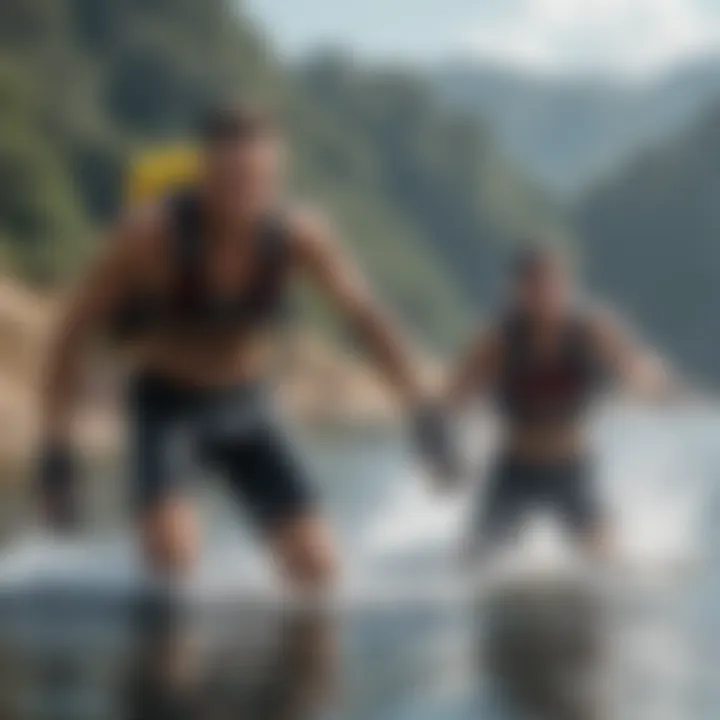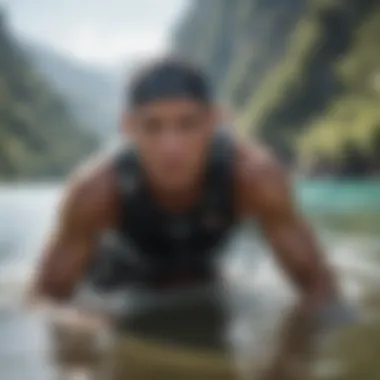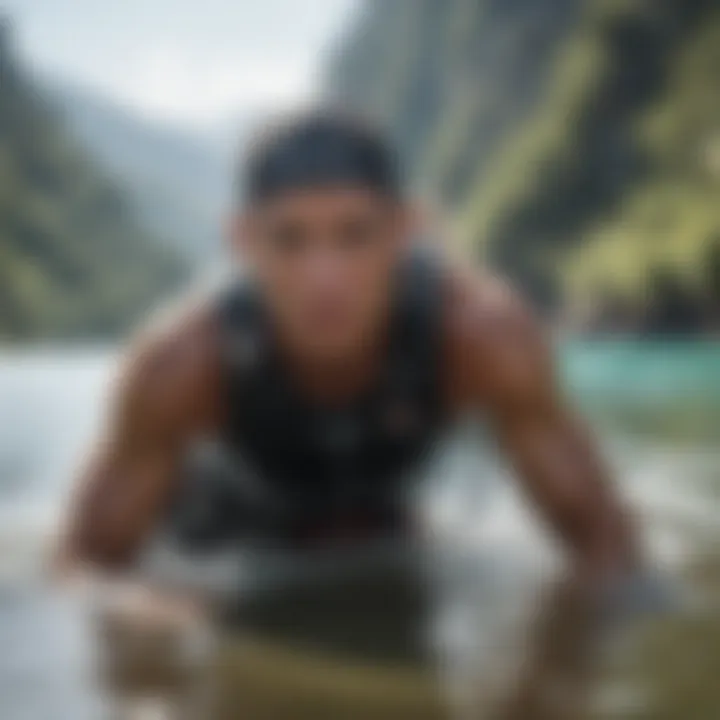Assessing Hydration Status for Watersports Enthusiasts


Intro
Staying hydrated while engaging in watersports is not just a matter of comfort; it influences performance and safety significantly. In environments where the sun blazes down and water splashes around, the need for proper fluid intake can easily slide down the priority list. This guide aims to shine a light on the multifaceted approach to assessing hydration status, especially tailored for watersport lovers.
Understanding the delicate balance between hydration and performance can be a game changer. It's essential to recognize that even mild dehydration could lead to fatigue, decreased coordination, and poor judgment. That isn’t just an inconvenience; it can pose serious risks when navigating through dynamic aquatic settings. So, whether you’re a novice paddler or a seasoned kite surfer, knowing how to gauge your hydration levels can keep you in the game longer.
Throughout this guide, we will delve into practical techniques to assess your hydration, the physiological cues your body may exhibit, and how these insights can be applied effectively during your time on the water. You’ll learn to not only monitor your hydration status but also to transform this knowledge into actionable steps that promote both performance enhancement and personal safety. It's about being equipped with the right insights so that your next adventure can be both exciting and safe.
Understanding Dehydration
Dehydration is more than just a lack of water; it’s a physiological state that can put a damper on performance and wellness, especially for those who thrive in watersport activities. Grasping the intricacies of dehydration is key when it comes to enhancing performance and remaining safe on the water. Water makes up a significant portion of our body mass and is essential for functions like temperature regulation, nutrient absorption, and even cognitive ability. When hydration dips, the ramifications aren’t just uncomfortable—they can be detrimental.
Defining Dehydration
Dehydration occurs when the body loses more fluids than it takes in, leading to an imbalance that can affect various bodily functions. It is essentially a situation where the water content in your body falls below optimal levels. Scientifically, dehydration is diagnosed when the body loses 1-2% of its total body weight in fluids. To put this into perspective, a person weighing 70 kg could be dehydrated after losing as little as 0.7 to 1.4 kg due to sweating or not drinking enough fluids.
It's also important to distinguish between mild, moderate, and severe dehydration. Mild dehydration might present as slight thirst or dry mouth, while moderate cases can lead to headaches, fatigue, and dizziness. Severe dehydration, however, is a medical emergency and may require immediate attention.
Causes of Dehydration
Dehydration can spring up from a variety of scenarios:
- Increased Physical Activity: Engaging in prolonged or intense watersport activities can rapidly deplete your body's hydration levels through sweat.
- Hot and Humid Conditions: When temperatures rise, the body tends to sweat more. This is especially relevant for watersports, where players may feel the heat as they exert themselves under the sun.
- Inadequate Fluid Intake: Forgetting to drink enough water can sneak up on anyone, particularly during a thrilling day on the waves.
- Illness: Conditions like fever, vomiting, or diarrhea significantly increase fluid loss.
These elements combine to create a perfect storm for dehydration, so staying mindful of these factors is crucial. Understanding the causes helps to avoid the all-too-common trap of neglecting hydration.
Impact on Performance
The effects of dehydration on physical performance may not be immediately visible but can be profound. Just a loss of 2% body weight from fluids can begin to impair performance. Here’s a closer look at what dehydration can mean for your athleticism:
- Decreased Endurance: Your body may tire more quickly, making activities feel tougher than they should.
- Altered Coordination: Balance and fine motor skills can suffer, turning seemingly simple movements into challenging tasks.
- Increased Risk of Injury: A dehydrated body is also more susceptible to cramping and injuries, which is the last thing you need when you're trying to enjoy your watersport pursuits.
Overall, being vigilant about hydration can mean the difference between conquering your next watersport challenge and feeling like you’re paddling upstream.
In short, by understanding the definition, causes, and effects of dehydration, sports enthusiasts, instructors, and sport marketers can not only preserve their edge in performance but also maintain their health. Making hydration a priority is essential for enjoying every splash and wave.
Recognizing Signs of Dehydration
To keep up our game in watersports, we gotta pay close attention to how our body feels and reacts. Recognizing signs of dehydration isn't just some health tip; it's a crucial skill for staying safe in and around water. The last thing any athlete or enthusiast wants is to be slowed down by dehydration when every second counts. It's like trying to run a race while dragging a boat anchor behind you—it just won’t work out well.
Understanding the red flags that our body sends can make a world of difference. When we’re out there in the sun or splashing in the waves, our hydration status can change faster than a wave rolls in. So, being aware of these signs enables us to take action before it's too late, helping us maintain peak performance while enjoying our time in the water.
Physical Symptoms
When you’re out on the water, there are several physical symptoms that can signal dehydration. At the top of the list is thirst—that classic indicator. If you're feeling parched, don’t ignore it. But here's the kicker: often by the time you feel thirsty, you're already behind the hydration curve!
Other physical symptoms to watch for include:
- Dry mouth and lips: If your mouth feels like the Sahara Desert, it's a clear sign you're not getting enough fluids.
- Dark yellow urine: Ideally, your urine should be pale yellow; dark urine often indicates inadequate hydration.
- Fatigue and dizziness: Feeling more worn out than usual or lightheaded? This is not just the waves talking; it could mean you're dehydrated.
- Headaches: A pounding head can often be traced back to not drinking enough water.
Keeping these physical signs in check, especially during intense activities, can help you stay ahead of the game.
Behavioral Indicators
Dehydration isn't just an internal battle; it can affect us on a behavioral level too. When our bodies aren't receiving sufficient hydration, we might see changes in how we act or feel.
- Irritability: You might find yourself snapping at teammates or anyone around you. It’s not just bad vibes; it could be dehydration whispering in your ear.
- Decreased motivation: If you usually dive head-first into your water activities but now feel like staying on shore, it’s time to re-evaluate your fluid intake.
- Increased muscle cramps: As dehydration sets in, you might notice those pesky muscle cramps making an unwanted appearance. They can be a real buzzkill when you're trying to give it your all.
It’s vital to monitor these behavioral changes, as they can be just as telling as physical symptoms. Often, they are windows into how well you’re hydrating.
Cognitive Effects
Hydration plays a big role in our brain function, and it can impact our performance in ways that are not immediately obvious. When you're paddling out, you need to be sharp and focused.
- Decreased concentration: If you feel like your mind is drifting or you’re having trouble focusing on your tasks, dehydration might be the culprit.
- Slower reaction times: In high-stakes watersports or even casual activities, quick reflexes are crucial. If you find yourself lagging, it could be due to insufficient fluid levels.
- Mental fatigue: Experiencing a foggy mind? It could feel like swimming through syrup. Staying hydrated can help keep your mind as nimble as your body.
The brain relies heavily on hydration, and any drop can lead to performance lags that affect decision-making and safety.


Staying hydrated is not merely about drinking water; it's a commitment to listen to your body and catch the signs early to keep your performance sharp.
In sums, recognizing the signs of dehydration means being proactive about our health and enjoyment during watersport activities. By keeping an eye out for physical symptoms, behavioral changes, and cognitive effects, we can all ensure that our time in the water is not only safe but also largely enjoyable.
Methods for Self-Assessment of Hydration
Assessing hydration status is crucial, particularly for those who engage in watersports. Misinterpreting this can lead to serious issues. Utilizing self-assessment methods aids in maintaining optimal hydration levels, which is vital for endurance, performance, and safety. Knowing how to monitor hydration effectively can serve as a powerful tool in the arsenal of athletes, coaches, and adventure seekers alike. Let's break down some actionable methods that can keep you on top of your hydration game.
Urine Color Chart
A simple yet effective way to gauge hydration involves observing urine color. The urine color chart serves as a visual guide in understanding your body's fluid status. Here's a quick overview:
- Clear: Well-hydrated. You’re doing great!
- Pale Yellow: Acceptable level of hydration.
- Dark Yellow: Indicates moderate dehydration; it may be time to drink up.
- Amber: Suggests strong dehydrations; stirring your hydration strategy is essential.
- Brown: Seek immediate hydration and possibly medical advice.
By consistently checking urine color throughout the day, you can easily adjust your fluid intake. One important consideration is that some foods and supplements may alter urine's appearance, such as beets or certain vitamins, which could mislead your readings. Thus, pay attention to external factors influencing urine color.
"The color of your urine can tell you a lot about your hydration status; it's a quick cue to drink water or pause for a while."
Body Weight Monitoring
Another practical method for assessing hydration is body weight monitoring. This technique involves weighing yourself before and after activities, particularly strenuous ones like swimming or kayaking. A drop in weight can indicate fluid loss. To do this correctly:
- Weigh yourself at the same time daily – Preferably in the morning before eating or drinking.
- Note changes when active – After any intense physical activity, weigh again. A loss of 1-2% of body weight typically hints at a significant fluid deficit.
- Adjust hydration accordingly – Use this information to figure out how much fluid you need to replenish.
By keeping track of your body weight, you can effectively manage your hydration strategy and avoid the detrimental effects of dehydration during competitive or leisurely activities.
Skin Turgor Test
The skin turgor test serves as a more hands-on method to check hydration status. This simple test can provide immediate feedback about your fluid levels.
To assess skin turgor:
- Pinch the skin on your forearm or back of the hand, hold it briefly, and then release.
- Observe how quickly it returns to its normal position:
- If it snaps back immediately, you are likely well-hydrated.
- If it takes time to return to normal, it may indicate dehydration.
While this examination offers quick insights, it may not be as reliable for older adults since skin elasticity can change with age. Nonetheless, it's a handy technique for anyone looking to quickly identify hydration issues.
Hydration Strategies for Watersport Activities
Hydration strategies are the backbone of maintaining optimal performance in watersport activities. When engaging in activities like kayaking, sailing, or paddleboarding, it’s easy to overlook hydration amidst the excitement. Yet, inadequate fluid intake can spell trouble—leading to fatigue, impaired coordination, and even severe health issues. A thoughtful approach to hydration before, during, and after water activities ensures not just better performance but also safety. Here, we discuss crucial elements and benefits associated with hydration strategies for these thrilling adventures.
Pre-Activity Hydration
Before diving into your watersport of choice, the steps you take in preparation can greatly impact your performance. Start your hydration process several hours prior to activity. Aim to drink adequate fluids that your body can absorb effectively. Common recommendations suggest at least 500 mL of water two to three hours before activity.
This phase serves multiple purposes:
- Pre-emptive Hydration: Giving your body the necessary fluids helps prevent dehydration before you even hit the water.
- Temperature Regulation: Staying well-hydrated can assist in maintaining your body's temperature, especially if you're partaking in warmer conditions.
- Cognitive Function: Adequate hydration also plays a role in mental acuity decision making.
Remember that simply gulping down water at the last minute won’t cut it. Instead, gradually introduce fluids into your routine. For those often involved in high-intensity sessions,k electrocytes can be beneficial to facilitate absorption and provide extra energy.
During-Activity Hydration
While you're engaged in watersports, forgetting to hydrate can cost you dearly. Factors such as prolonged exposure to sun, heat, wind, and even the physical intensity of your activities can exacerbate fluid loss. During your time on the water, it's advisable to drink fluids regularly. Aim for about 200 to 300 mL of water every 15 to 30 minutes.
Key considerations for effective during-activity hydration include:
- Accessibility: Carrying a hydration pack or water bottle that's easy to access ensures you don’t skip sipping throughout your session.
- Electrolytes Play a Role: Sports drinks with electrolytes are particularly significant in long-duration activities. They help replenish lost sodium, potassium, and magnesium, which are essential for optimal muscle function.
- Body Signals: Paying attention to thirst cues is vital. If you wait until you're thirsty, you may already be slightly dehydrated. Some athletes find setting a timer or reminder can help maintain a regular intake.
Post-Activity Recovery
After stepping out of the water, don’t think the hydration battle is over. Recovery hydration is crucial for muscle repair and replenishing fluids and nutrients lost through sweat. Start by drinking approximately 500 to 750 mL of water within 30 minutes of finishing your activity. This initial phase can help speed up recovery and prevent post-exercise dehydration symptoms.
In the recovery stage, consider these elements:
- Electrolyte Restoration: Consuming electrolyte-rich beverages can greatly benefit recovery. Coconut water, sports drinks, or electrolyte tablets can be a smart choice.
- Balanced Nutrition: Rehydrating isn’t just about liquids; it’s also beneficial to consume a balanced meal featuring proteins and carbohydrates to support muscle recovery and energy restoration.
- Monitoring Fluid Loss: Use body weight as a monitor. Losing about 1 kg during activity equates to approximately one liter of fluid loss, suggesting how much you should aim to rehydrate.


"Staying ahead with hydration isn’t a solo act; it’s a team effort involving preparation, awareness, and smart recovery strategies that set the stage for enthusiastic performance amidst ever-changing water conditions."
By adopting these hydration strategies, you not only enhance your performance but can also enjoy your watersport activities with a greater sense of security and well-being.
The Role of Electrolytes in Hydration
Maintaining proper hydration goes beyond simply consuming water; it requires an understanding of electrolytes and their profound impact on our body's fluid balance. These charged particles, primarily sodium, potassium, calcium, and magnesium, play pivotal roles in maintaining cellular functions and overall physiological balance. For watersports enthusiasts, comprehending this aspect is vital as it directly influences performance and safety during aquatic activities.
Electrolytes are essential for several bodily functions, including muscle contraction, nerve transmission, and maintaining acid-base balance. When one engages in physical activities, especially in intense conditions or prolonged durations, electrolyte loss can occur through sweat, leading to imbalances that can affect one's performance and health.
"Hydration is not merely about drinks. It involves balancing water with electrolytes for optimal performance."
Understanding Electrolyte Balance
Electrolyte balance represents the equilibrium between fluid intake and the loss of electrolytes through sweat, urine, and other mechanisms. An imbalance can lead to issues such as dehydration or overhydration, culminating in severe health consequences. Proper electrolyte levels help regulate the body’s fluid retention, making it crucial for anyone exposing themselves to vigorous physical activity.
Typically, dehydration occurs when the body loses more electrolytes than it takes in, which is common in lush sports like sailing or water skiing where high stamina is required. Understanding how your body uses electrolytes can help in crafting effective rehydration strategies. This is where self-awareness plays a core part: listening to your body and responding promptly to signs of electrolyte depletion.
Sources of Electrolytes
To maintain a good electrolyte balance, it’s important to consume foods and drinks that will replenish these vital minerals. Common sources of electrolytes are:
- Fruits and Vegetables: Bananas (rich in potassium), spinach (high in magnesium), and oranges (loaded with calcium) are fantastic options.
- Sports Drinks: Specialized drinks designed for athletes often contain a mix of carbohydrates and electrolytes that help restore balance quickly.
- Coconut Water: This natural drink has gained popularity for its natural electrolyte content, particularly potassium, which makes it a great option in summer or tropical climates.
- Broths: Bone broth or vegetable broth can also be an excellent way to hydrate while replenishing those essential nutrients.
Integrating these sources into your diet not just helps in staying hydrated, but also enhances stamina and performance levels.
Electrolyte Supplements
In certain scenarios, especially for intensive training or extended periods of training, relying solely on food sources might not suffice. Here’s where electrolyte supplements can come into play. These supplements are available in various forms, including powders, tablets, and ready-to-drink solutions. They can be particularly useful when:
- Participating in endurance sports, such as triathlons or long-distance running.
- Experiencing high heat or humidity where fluid loss is accelerated during activity.
- Dealing with conditions that can lead to significant fluid or electrolyte loss, such as vomiting or diarrhea.
While they offer convenience, it’s important to choose quality supplements carefully, ensuring they provide adequate levels of the necessary electrolytes, without excessive sugars or artificial additives. Balancing supplementation with adequate hydration practices will ensure you remain at your best.
To effectively manage hydration while enjoying watersports, consider consultation with a nutritionist or a coach who understands the unique demands of such activities. This insight can be invaluable in developing a tailored hydration strategy, keeping your electrolyte balance in check and ensuring top-notch performance.
Hydration Myths Debunked
In the realm of hydration, misinformation can be just as damaging as insufficient water intake. Misconceptions about hydration are pervasive and can affect athletic performance, recovery, and overall health. This is crucial for individuals engaging in watersports, where staying hydrated is not just a suggestion, but a necessity. Understanding the facts behind hydration myths is vital for making informed choices and ensuring optimal physical performance.
Common Misconceptions
Many widely-held beliefs about hydration can lead to detrimental practices. For instance, a common thought is that drinking water only when thirsty is sufficient for hydration. This mindset overlooks the body's early signs of dehydration, such as fatigue or decrease in performance.
Here are some typical myths:
- Myth 1: Clear urine always means hydration. While clear urine can indicate hydration, other factors—like diet and certain medications—can affect urine color.
- Myth 2: Sports drinks are always better than water. Sports beverages are beneficial during intense or prolonged activity, but regular hydration needs can often be met with plain water.
- Myth 3: Coffee and tea cause dehydration. Despite being diuretics, moderate consumption of caffeinated beverages does not significantly contribute to dehydration.
These misconceptions can mislead athletes, leading to poor hydration strategies and potentially affecting performance.
Fact vs. Fiction
Disentangling fact from fiction is essential for effective hydration practices. Knowledge can prevent injuries, complications from heat stress, and ensure optimal performance.
- Fact: Hydration needs vary based on activity intensity, environmental conditions, and individual physiology. It’s important to tailor hydration strategies to fit personal requirements.
- Fiction: All hydration comes from drinking. In reality, food also plays a role in hydration. Fruits and vegetables, for example, have high-water content and can contribute to overall fluid intake.
"The value of staying informed about hydration cannot be overstated. Myths persist; facts empower."
- Fact: Electrolytes play a significant role in hydration, especially in hot conditions. Replenishing lost salts through food or supplements can enhance hydration.
- Fiction: It’s unnecessary to hydrate before feeling thirsty. Thirst is a late indicator of dehydration; proactive hydration is crucial, especially before engaging in water-based activities.
Dispelling these myths leads to improved hydration practices, essential for anyone who values their performance in aquatic settings. By embracing accurate information, watersport enthusiasts can stride more confidently into their activities, equipped to make wise hydration choices.
Adapting to Various Climates
Hydration is not a one-size-fits-all process. It is significantly influenced by environmental conditions, particularly the climate one finds themselves in. For watersports enthusiasts, adapting hydration strategies based on climate can make the difference between a thrilling day on the water and an unfortunate experience marred by fatigue or worse. Proper adjustments not only enhance performance but also safeguard health. Let’s explore how different climates affect hydration practices, focusing on two common scenarios: hot, humid conditions and cold weather.
Hot and Humid Conditions


Engaging in watersports under the sun can often feel like navigating through a sauna. High temperatures and humidity levels ramp up sweat production, which is the body's mechanism for cooling itself. This means that staying hydrated is more crucial than ever in these conditions.
Key considerations include:
- Increased Fluid Loss: While enjoying activities, it's easy to overlook the amount of time spent under the sun and the resulting perspiration. One may not always feel thirsty, yet the body could be losing significant fluids. Hence, it's a good idea to drink water even when not feeling parched.
- Electrolyte Deficiency: Sweating leads to a loss not just in water but also in essential electrolytes such as sodium and potassium, which can lead to cramps or dizziness. For long sessions, consider drinks with electrolytes like coconut water or commercial sports drinks that replace lost minerals.
- Preemptive Measures: Before heading out for your activity, enjoy a hydrating meal packed with fruits and vegetables; things like watermelon, cucumbers, and oranges can provide extra hydration while also being refreshing.
Practical Tips:
- Carry a reusable water bottle; it should always be at arm's length.
- Set a timer on your phone to remind yourself to take sips regularly.
- Consider wearing light-colored and breathable clothing. This minimizes heat retention and sweat production.
"Hydration is key. It’s the glue that holds our body together, especially under the sun." - Rebecca, avid kayak enthusiast.
Cold Weather Considerations
While one might associate cooler temperatures with less risk of dehydration, the reality for athletes is quite different. Cold air can sap moisture from the body quickly, and engaging in watersports in chilly conditions adds another layer of complexity to hydration practices.
Factors to keep in mind:
- Decreased Thirst Response: The body’s thirst signals can become dulled in colder conditions. Just like the heat, a lack of thirst does not equate to adequate hydration. Make it a habit to hydrate regularly, rather than waiting for thirst cues.
- Wind and Water Exposure: Even if the outside temperatures are mild, wind chill and cold water can exacerbate fluid loss through perspiration and breath. Even in temperatures that feel comfortable, maintaining hydration is crucial.
- Heat from Activity: Engaging in high-energy sports generates internal heat leading to perspiration. If one doesn’t replace this lost moisture, dehydration can creep in unnoticed.
Best Practices for Cold Weather:
- Drink warm fluids like herbal tea to help retain body heat while promoting hydration.
- Opt for insulated water bottles to keep drinks warm or drinks that can help ward off the chill.
- Monitor urine color regularly; it should remain light-colored to signify adequate hydration.
Successful hydration strategies are about knowing your environment and adjusting accordingly. While the sun poses its challenges, cold conditions can be equally deceptive. By being proactive and aware, watersport lovers can effectively navigate these challenges, maximizing their performance while minimizing the risks associated with dehydration.
The Connection Between Hydration and Injury Prevention
In the realm of sports, particularly for watersport enthusiasts, hydration’s role isn’t just about quenching thirst. Rather, it serves as a pivotal factor in injury prevention. Staying adequately hydrated not only maximizes performance but also mitigates the risks of various injuries, enhancing overall safety in challenging aquatic environments.
Why Hydration Matters
Dehydration can lead to a myriad of issues that inhibit an athlete's abilities and put them at risk of injury. The physiological effects from lacking sufficient fluids can manifest in several ways:
- Diminished muscle function: Muscles require water for optimal contraction and relaxation. When hydration levels dip, muscles may not function efficiently, leading to an increased likelihood of cramps and strains.
- Reduced coordination and balance: Lack of fluids can impair cognitive functions, which translates to a higher chance of accidents during high-intensity activities.
- Delaying recovery: Proper hydration is crucial for cellular repair and muscle recovery, making it harder for athletes to bounce back after rigorous activity.
Understanding these connections is vital for athletes, coaches, and instructors who are navigating the challenges of competitive watersports.
Muscle Cramps and Dehydration
Muscle cramps can sneak up on you when you least expect them, often as a result of insufficient hydration. When the body is dehydrated, the balance of electrolytes — such as sodium, potassium, and calcium — becomes disrupted. These electrolytes are esencial for muscle function.
- What happens?
Dehydration causes rapid shifts in electrolyte levels, leading to involuntary muscle contractions, commonly known as cramps. For instance:
- A kayaker may feel a sudden cramp in their calf due to inadequate sodium levels after an intense paddling session.
- A swimmer might be unable to continue laps due to cramping in their arms, which can be traced back to insufficient hydration during practice.
Keeping an eye on hydration status can help in preventing these discomforting and often debilitating muscle cramps from occurring, allowing watersport athletes to maintain their competitive edge.
Joint Function and Hydration
Lubricating the joints may not be top of mind, yet it is crucial in preventing injuries. Water serves as a major component in synovial fluid, which acts as a lubricant in joints, enabling smoother movement and reducing friction.
- Impact on performance: Proper fluid intake promotes joint health, ensuring that athletes can perform demanding movements without the fear of joint strain or injuries.
- Think of a surfer going for that perfect wave; hydration ensures that their knee joints can handle the maneuvering without resulting in discomfort or injury.
- Similarly, water skiers need to maintain joint stability to avoid falls, which can lead to injuries.
Moreover, dehydration can exacerbate chronic conditions such as arthritis, leading to long-term issues that can derail an athlete’s career.
"Proper hydration not only maximizes performance but also acts as a guardian against injuries, ensuring athletes can continue doing what they love."
Epilogue and Best Practices
In the realm of hydration, especially pertinent for those who engage in watersports, understanding how to assess one's hydration status is of paramount importance. Keeping your body in tip-top shape relies heavily on how well you maintain adequate fluid balance. This guide has traversed various dimensions of hydration—from recognizing the signs of dehydration to learning practical self-assessment methods. Yet, it all boils down to effectively adopting best practices.
Grasping the nuances of hydration enables athletes and enthusiasts alike to optimize performance, stave off health issues, and make informed decisions specific to their activities and environmental conditions. The final stretch of our exploration encapsulates key takeaways and results in actionable recommendations for better hydration practices.
Summary of Key Points
- Understand Dehydration: Familiarity with what dehydration is, its causes, and its performance impacts is vital.
- Recognizing Symptoms: Being aware of both physical and cognitive indicators can make a significant difference in safeguarding your health.
- Self-Assessing Hydration: Utilize various methods, such as the urine color chart and skin turgor testing, to gauge your hydration levels accurately.
- Electrolyte Importance: Awareness about how electrolytes influence hydration and recovery is also crucial, particularly in humid or extreme weather conditions.
- Combat Myths: Distinguishing facts from misconceptions about hydration can help you implement more effective strategies.
- Climatic Adaptation: Knowing how hydration needs shift between hot and cold environments is essential for maintaining performance.
Hydration is not just about drinking water; it's about understanding the body's needs and responding appropriately.
Final Recommendations
To embody the principles discussed, consider these final recommendations:
- Stay Proactive: Don’t wait until you feel thirsty. Make it a habit to drink fluids regularly, especially during intense physical activities.
- Use Technology: Implement apps or wearable technology to track your fluid intake and remind you to hydrate. An informed mind tends to make better choices.
- Choose Wisely: Opt for hydrating foods like fruits and vegetables; cucumber and watermelon are solid choices that offer hydration and nutrients.
- Electrolyte Potency: In high-sweat scenarios, consider drinks with balanced electrolytes. Not all beverages are worth your time, so check the labels carefully to avoid sugar overload.
- Adapt to Conditions: Be mindful of weather conditions when planning hydration strategies. Adjust your intake based on heat or cold exposure to address your body's changing demands.







